| Listing 1 - 10 of 17 | << page >> |
Sort by
|
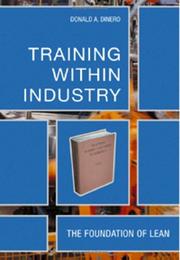
ISBN: 1563273071 Year: 2005 Publisher: New York : Productivity Press,
Abstract | Keywords | Export | Availability | Bookmark
 Loading...
Loading...Choose an application
- Reference Manager
- EndNote
- RefWorks (Direct export to RefWorks)
H3 2006 Shingo Prize for Excellence in Manufacturing Research /h3 p b i Training Within Industry /i /b, by Donald Dinero, explores a crucial piece of a Lean initiative that has been overlooked throughout U.S. industry. The Training Within Industry (TWI) program - developed by the United States during World War II - has been used by Toyota for decades! This powerful program standardizes training processes and assists front-line supervisors in teaching new operations to workers quickly and effectively. /p p Dinero completely explores the history and application of the four modules that compose TWI: i Job Instruction /i - in which employees are trained to perform their tasks as quickly as they are capable with minimal waste; i Job Methods /i - in which employees are taught how to improve their processes using existing resources; i Job Relations /i - in which personnel problems are solved in an analytical, non-emotional manner so that employees are focused on a stated objective; and i Program Development /i - in which robust training plans are developed to meet the particular needs of a specific plant. p Readers of b i Training Within Industry /i /b will see that standardized work imparts measurable continuous improvement because it sets a baseline. It establishes a framework for efficiency and innovation. /p p In addition, the book includes a CD containing the text of original TWI bulletins issued by the U.S. government in the 1940s. /p h4 Unique and Compelling Features and Benefits: /h4 UL LI Provides a key to successfully implementing Lean Thinking /LI LI Provides basic knowledge without any non-valued added material /LI LI Applies to all positions in all industries /LI LI Time tested - has been used for over sixty years and is still successful /LI /UL
Employees --- Industrial efficiency. --- Industrial management. --- Organizational effectiveness. --- Training of.
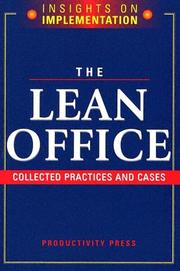
ISBN: 1563273160 Year: 2005 Publisher: New York, N.Y. : Productivity Press,
Abstract | Keywords | Export | Availability | Bookmark
 Loading...
Loading...Choose an application
- Reference Manager
- EndNote
- RefWorks (Direct export to RefWorks)
p b i The Lean Office: Collected Practices and Cases /i /b is a compilation of articles previously published in our monthly newsletter, b i Lean Manufacturing Advisor /i /b . These articles discuss lean implementations in non-manufacturing operations, from design to processing invoices to customer service. Most articles are written in the form of case studies. /p p b Highlights include: /b ul li Practical, in-depth description of lean implementation, written in a conversational, easy-to-read style /li li A large quantity of case studies unavailable from any other single source /li li Responds to your desire for real-world lean office information /li /ul br
Industrial efficiency. --- Industrial management --- Office management --- Organizational effectiveness. --- Cost control.
Book
Abstract | Keywords | Export | Availability | Bookmark
 Loading...
Loading...Choose an application
- Reference Manager
- EndNote
- RefWorks (Direct export to RefWorks)
"The city-state of Singapore has achieved rapid economic development in the past by its positioning as an efficient business hub in Asia. To remain competitive in the global knowledge economy, however, Singapore needs to move beyond efficiency by developing a strong "innovative" edge as well. This paper examines the challenges that Singapore faces in seeking to do so through an explorative survey of 40 firms from three innovative sectors: high-tech manufacturing industries, knowledge-intensive business services (KIBS), and creative content industries. Overall, while the survey confirms Singapore's continuing competitive strength in efficiency infrastructure, it also finds a favorable perception of Singapore as an innovative city. Indeed, many of the industry actors indicated that an efficient business infrastructure is a prerequisite for locating their innovative activities in Singapore, suggesting that the relationship between innovation and efficiency is complementary, rather than substitutional. While the study found that intellectual property and its protection are widely recognized by actors in all three sectors, interesting differences exist. In particular, intellectual property protection appears to be of greater concern to the high-tech research and development-intensive manufacturing sector and the creative contents sector than to the KIBS sector. Another interesting difference is that while competition in high-tech innovation tends to be global, competition in creative content tends to have a stronger local or regional dimension. Public policy in East Asia has traditionally emphasized the development of technological innovation capabilities in the manufacturing sector. In light of the findings, public policymakers may need to be more sensitive to the nuanced differences in policies needed to promote the new creative content industries and the associated supporting KIBS. "--World Bank web site.
Creative ability in business --- Industrial efficiency --- Technological innovations --- Economic aspects
Book
Abstract | Keywords | Export | Availability | Bookmark
 Loading...
Loading...Choose an application
- Reference Manager
- EndNote
- RefWorks (Direct export to RefWorks)
"The city-state of Singapore has achieved rapid economic development in the past by its positioning as an efficient business hub in Asia. To remain competitive in the global knowledge economy, however, Singapore needs to move beyond efficiency by developing a strong "innovative" edge as well. This paper examines the challenges that Singapore faces in seeking to do so through an explorative survey of 40 firms from three innovative sectors: high-tech manufacturing industries, knowledge-intensive business services (KIBS), and creative content industries. Overall, while the survey confirms Singapore's continuing competitive strength in efficiency infrastructure, it also finds a favorable perception of Singapore as an innovative city. Indeed, many of the industry actors indicated that an efficient business infrastructure is a prerequisite for locating their innovative activities in Singapore, suggesting that the relationship between innovation and efficiency is complementary, rather than substitutional. While the study found that intellectual property and its protection are widely recognized by actors in all three sectors, interesting differences exist. In particular, intellectual property protection appears to be of greater concern to the high-tech research and development-intensive manufacturing sector and the creative contents sector than to the KIBS sector. Another interesting difference is that while competition in high-tech innovation tends to be global, competition in creative content tends to have a stronger local or regional dimension. Public policy in East Asia has traditionally emphasized the development of technological innovation capabilities in the manufacturing sector. In light of the findings, public policymakers may need to be more sensitive to the nuanced differences in policies needed to promote the new creative content industries and the associated supporting KIBS. "--World Bank web site.
Creative ability in business --- Industrial efficiency --- Technological innovations --- Economic aspects
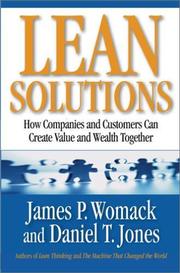
ISBN: 0743277783 9780743277785 Year: 2005 Publisher: New York Free Press
Abstract | Keywords | Export | Availability | Bookmark
 Loading...
Loading...Choose an application
- Reference Manager
- EndNote
- RefWorks (Direct export to RefWorks)
Customer relations --- Industrial efficiency --- Organizational effectiveness --- Value added
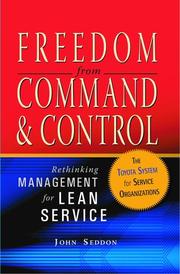
ISBN: 1563273276 Year: 2005 Publisher: New York : Productivity Press,
Abstract | Keywords | Export | Availability | Bookmark
 Loading...
Loading...Choose an application
- Reference Manager
- EndNote
- RefWorks (Direct export to RefWorks)
H4 i "Command and Control is failing us. There is a better way to design and manage work - a better way to make work work - but it remains unknown to the vast majority of managers." /i /h4 p b i Freedom from Command and Control: Rethinking Management for Lean Service /i /b, by John Seddon, applies the Toyota Production System (TPS) to service organizations. It explains how the traditional command-and-control management paradigm of top-down decision making has created high costs and poor service quality -- managers are left detached from their employees and remote from their operations. Seddon demonstrates that a change in management thinking, one from decision making based on activity-related measures (such as budgets, standards, and targets) to purpose-related measures (such as putting customers first and improving services) can help managers reconnect with their operations, see the waste caused by the current organization design, and exploit opportunities for improvement. /p p This book breaks new ground -- it posits that the service industry is fundamentally different from manufacturing and shows how TPS principles must be transformed for application in service organizations. Through extensive case material, it explains the difference between command and control and systems thinking and illustrates how the latter leads to improved service, better revenues, lower costs, and higher staff morale. /p
Book
Year: 2005 Publisher: [Washington, D.C. : World Bank,
Abstract | Keywords | Export | Availability | Bookmark
 Loading...
Loading...Choose an application
- Reference Manager
- EndNote
- RefWorks (Direct export to RefWorks)
"This paper looks at Singapore's efforts to transform the economic growth base from one that is predominantly efficiency-driven to one that is more innovation-driven. To accelerate the transition process, the government is aggressively investing in "innovation infrastructure"-systems and institutions that make the city a more conducive environment for innovations. The modus operandi, with a distinctive "winner-picking" flavor, mirrors that of its earlier strategic industrial policy in building up the manufacturing sector. It is also in sync with the new urban growth literature which argues that the success of any innovation-driven growth strategy depends on a city's ability to attract a large community of creative individuals in different fields. Innovation infrastructure building requires more than putting in the right systems. It also requires a mindset change at various levels of society. This paper looks at how the government's policy philosophy and practices have evolved over time, and discusses the effectiveness of the government-led, strategic supply-push approach in propelling Singapore onto an innovation-driven growth path. It takes into consideration the city-state's underlying comparative advantages (or disadvantages) and asks how Singapore's existing strength in efficiency infrastructure may give it a first mover advantage in attracting creative talent, how its success may be affected by the small size of the economy, and the various political and social constraints that a small sovereign city-state faces. These issues are explored against the backdrop of the keen competition among the major cities in the region to become an innovation hub. "--World Bank web site.
Creative ability in business --- Industrial efficiency --- Technological innovations --- Economic aspects --- Singapore --- Economic conditions.
Book
Year: 2005 Publisher: [Washington, D.C. : World Bank,
Abstract | Keywords | Export | Availability | Bookmark
 Loading...
Loading...Choose an application
- Reference Manager
- EndNote
- RefWorks (Direct export to RefWorks)
"This paper looks at Singapore's efforts to transform the economic growth base from one that is predominantly efficiency-driven to one that is more innovation-driven. To accelerate the transition process, the government is aggressively investing in "innovation infrastructure"-systems and institutions that make the city a more conducive environment for innovations. The modus operandi, with a distinctive "winner-picking" flavor, mirrors that of its earlier strategic industrial policy in building up the manufacturing sector. It is also in sync with the new urban growth literature which argues that the success of any innovation-driven growth strategy depends on a city's ability to attract a large community of creative individuals in different fields. Innovation infrastructure building requires more than putting in the right systems. It also requires a mindset change at various levels of society. This paper looks at how the government's policy philosophy and practices have evolved over time, and discusses the effectiveness of the government-led, strategic supply-push approach in propelling Singapore onto an innovation-driven growth path. It takes into consideration the city-state's underlying comparative advantages (or disadvantages) and asks how Singapore's existing strength in efficiency infrastructure may give it a first mover advantage in attracting creative talent, how its success may be affected by the small size of the economy, and the various political and social constraints that a small sovereign city-state faces. These issues are explored against the backdrop of the keen competition among the major cities in the region to become an innovation hub. "--World Bank web site.
Creative ability in business --- Industrial efficiency --- Technological innovations --- Economic aspects --- Singapore --- Economic conditions.
Periodical
ISSN: 21825114 Year: 2005 Publisher: Caparica, Portugal : Universidade Nova de Lisboa, Faculdade de Ciências e Tecnologia, IET Centro de Investigação em Inovação Empresarial e do Trabalho
Abstract | Keywords | Export | Availability | Bookmark
 Loading...
Loading...Choose an application
- Reference Manager
- EndNote
- RefWorks (Direct export to RefWorks)
Teams in the workplace --- Industrial efficiency --- Organizational effectiveness --- Industrial efficiency. --- Organizational effectiveness. --- Teams in the workplace. --- Groups, Work --- Team building in the workplace --- Team work in the workplace --- Teambuilding in the workplace --- Teams, Work --- Teamwork in the workplace --- Work groups --- Work teams --- Social groups --- Work environment --- Management --- Organization --- Efficiency, Industrial --- Industrial management
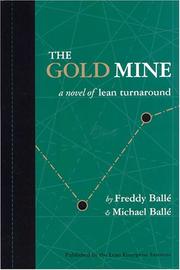
ISBN: 0974322563 9780974322568 Year: 2005 Publisher: Brookline, MA : Lean Enterprise Institute,
Abstract | Keywords | Export | Availability | Bookmark
 Loading...
Loading...Choose an application
- Reference Manager
- EndNote
- RefWorks (Direct export to RefWorks)
Production management --- Industrial efficiency --- Organizational behavior --- Problem solving --- Teams in the workplace --- Production --- Efficience dans l'industrie --- Comportement industriel --- Résolution de problèmes --- Equipes de travail --- Fiction --- Gestion --- Romans, nouvelles, etc. --- Résolution de problèmes --- Fiction.
| Listing 1 - 10 of 17 | << page >> |
Sort by
|

 Search
Search Feedback
Feedback About
About Help
Help News
News